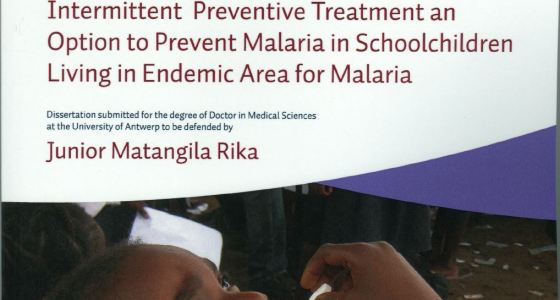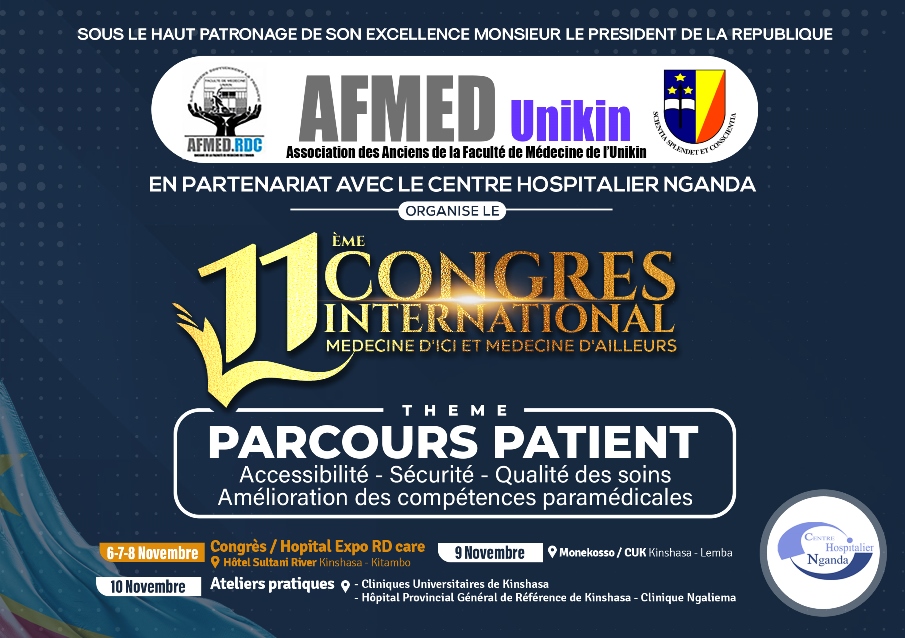Bravo au Jeune PhD Dr Junior Matangila Rika, travail defendu à Anvers (Belgique)
Promoteurs
Prof. Dr. Jean-Pierre Van geertruyden
Prof. Dr. Pascal Lutumba
Faculty of Medecine and Health Sciences
Antwerp 2016

Summary
Malaria affects school aged children’s health and school performances. However, in malaria
endemie areas, malaria related research and interventions are mainly directed towards weil
known risk groups such as: pregnant women and children aged less than five years. To date a
few preventive strategies have been suggested, and intermittent preventive treatment (IPT) is
among the most promising. The drug regimen, efficacy and safety profile of anti-rnalarial drugs
used to prevent P. falciparum infection in pregnant women and infants and, to a lesser extent,
children of less than five years, have been widely investigated. However, there is paucityof
data about malaria burden in schoolchildren and the appropriated way to prevent malaria and
its consequences in this group. Intermittent preventive treatment appears to be the most adapted
strategy to tackle malaria in schoolchildren in regard to the fact that the y usually harbour
malaria parasites, with less or without symptoms, and thus, not treated in practice. Moreover,
theyare less likely to sleep under a bed net. The present thesis aimed to assess IPT as a mean
to prevent malaria and its effects on schoolchildren’s health.
To determine the most promising drug regirnen for IPT in schoolchildren (IPTsc), we conducted
a systematic review of previous available data. Only five studies were identified as IPTsc.
Dihydroartemisinin-piperaquine (DP) given monthly provided the highest protection against
asymptomatic and clinical malaria and anaemia. Contrarily, Sulfadoxine-pyrimethamine (SP)
monotherapy was the poorest drug regimen, and should not be considered for lPTsc in settings
of SP resistance. However, combination of two long hall-life (SP+AQ) showed acceptable
protection against asymptomatic and c1inical malaria and anaemia, while allowing a fourmonthly
dosing interval, suggesting that other combinations of two half-Iife drugs should be
prioritized for further investigational trials. ln almost ail studies, adverse events associated to
interventional drugs were judged mild or moderate.
A randomized controlled trial (RCT) was conducted to evaluate the efficacy and safety of SP
and SP plus piperaquine (PQ) as IPT in Congolese schoolchildren. Baseline data showed that
malaria parasitaemia was highly prevalent and strongly associated to anaemia. Clinical malaria
presentation was complex including children experiencing mild or weil tolerated symptoms and
others presenting acute malaria symptoms. This RCT portrayed that SP+PQ should be
considered as an effective drug regimen to prevent malaria in schoolchildren, in virtue of its
acceptable efficacy and safety and its feasible scheme, allowing a four-rnonthly dosing interval.
ln contrast, SP alone should not be considered as an effective mean to prevent malaria and its
related adverse effects in schoolchildren living in endemie area for malaria.
Like other preventive strategies, the successful implementation of IPTsc will also depend on
acceptability of key stakeholders such as parents and teachers. Therefore, we conducted a
qualitative research, following the RCT, to understand the school community perception and
experience with Il’Tsc. The results reveal that parents/legal tutors and teachers were divided
into two groups (adherent and not adherent to [PT). For those who did not adhere, drug used
for IPTsc was not safe. Most adherent parents/ legal tutors preferred to confirrn a malaria
infection before treatment. The possibility ofallowing teachers to give IPTsc drugs also divided
parents/legal tutors into two major groups (willing and not willing). Willing parents required a
short training in order to enable them to safely administer drugs to children. Those not willing
suggested the use of health works for this task.
Intermittent preventive treatment using SP+PQ may be a good option for malaria prevention in
schoolchildren living in endemie area for malaria. However, more studies evaluating this
combination in other endemie areas must be conducted to bring more evidence of its
effectiveness and efforts to i









